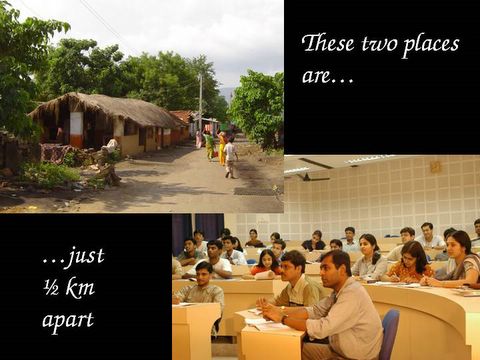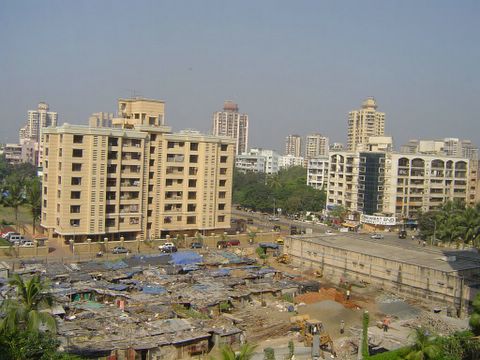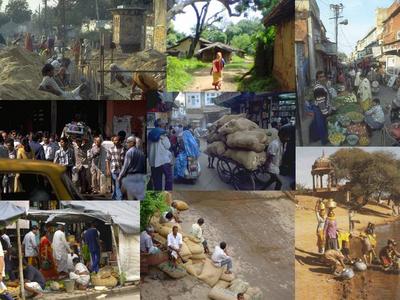
The Distance! 
I know both these places, because I teach in one and often walk through the other. This schizophrenic experience has also made me realize what an insurmountable gulf a mere ½ km can be …

Foundations of Prosperity 
One way I can make sense out of this is to visualize that we live in two India(s) – these two realities coexist side-by-side in a surrealistic blend:
This posting is an attempt to understand these two India(s). One may say that this is a sort of anthropological exploration of two continents/ paradigms/ realities – which co-exist, and yet do not (perhaps) understand the other side
The Visible India: The Visible India is visible because it is the proverbial tip-of-the-iceberg. It is also the convenient constituency of media, and therefore plays an influential part of metropolitan debates and conversation, and in forming perceptions about India.
The Visible India is visible because it is the proverbial tip-of-the-iceberg. It is also the convenient constituency of media, and therefore plays an influential part of metropolitan debates and conversation, and in forming perceptions about India.
Only about 15% of India’s 190mn households have an annual household income of more than Rs 2.5 lacs (Rs 0.2.5mn). Assuming 5 persons / household, these approx. 150mn people (out of 1bn) are the solid citizens of Visible India. There must be another 100mn or so who also exist on the periphery of this demographic continent (or believe that they do)
Citizens of the Visible India share two common features:
1. irrespective of their income-levels, they like to describe themselves as the “middle-class”. They also believe that the “middle class” is a synonym for the “common man” or the representative citizen of India.
2. they see consumption as an inalienable right, and like to describe themselves as “consumers” or “customers”… In the Visible India, there is no such term like a Middle-Class Producer.
The consumption of the Visible India contributes substantially to India’s GDP. For instance, during 2004, its inhabitants downloaded ring-tone worth Rs. 400 crores (Rs. 4bn) on their mobile/cell phones, and they contributed an estimated Rs. 1500 crores (i.e., Rs.15bn) to GDP during Valentine Day, and so on…
The Visible India likes numbers, and believes in their magical quality in capturing the reality. Numbers like “GDP”, “FDI”, “Global Competitiveness Index”, “Profits”, “Market Share”, etc. are important to them; their personal self-esteem goes up and down with these numbers.
One of the magical numbers, for instance, which its inhabitants like is “Sensex” – it is seen as an indicator of the health of Indian economy/business. Its “magical” quality lies in the fact that it is based on the behaviour of about 35-40mn investor population (about 0.4% of India’s total population), as they buy and sell the “dead stocks” of a handful (30-50) of India’s companies.
The inhabitants of the Visible India also like words such as “privatization”, “globalizations”, “competitiveness”, etc., which they see as signs of progress and development.
Correspondingly, by and large, they feel that nation-states and government have (or should have) less role to play in “economic” development. The also feel that nations are economies and not societies.
Quite a few of those living in the Visible India – hopefully, not all – are also skeptical about “democracy” in India. Some, in fact, also feel that “we have too much democracy” and prefer not to participate in it.
Nevertheless, they do expect an elected government to provide them with “world-class infrastructure”, take care of the “consumers’ interests”, reduce taxes, abolish regulations, etc…. all in the same breath!!! – more often than not, they also succeed!!!
Citizen of the Visible India like to live on debts – credit cards, consumer finance schemes, loans, etc. – the higher the debt, the greater one’s “credit worthiness”.
Lastly – actually, not lastly – one can go on elaborating - , the Visible India holds a premium on the “brands” that one buys, the “address” one lives in, the “life-style” on leads, the “CV-value” of one’s activities, etc.
Etc. etc……
The Invisible India:

The Invisible India is invisible because it is so ubiquitous and pervasive - it gets merged in the background of the hectic lives of those who live on the other side of reality. It remains a taken-for-granted, nondescript, an apparently needless distraction, except for those who live in it.
About 92-93% of India’s active workforce lives in this reality… Actually, they live in slums, shanties, and villages.
The economists say that they belong to the “informal”/ “unorganized”/ “marginal” sector… which actually is funny, since this “informal” sector accounts for around 2/3rd of the workforce even in all metropolitan cities (Delhi, Mumbai, Chennai, etc.)… but then most economists live in the Visible India…
These denizens of the Invisible India follow diverse professions – hawkers, vendors, roadside tailors, mechanics, contract labours, construction and agricultural workers, domestic workers, weavers, potters, papad-rollers, handcart pullers, laundry workers, etc.
…and account for 60% of India’s GDP!
In a way, they are India’s truly self-employed privatized citizens – no government support, no income or social security, no access to formal credits, no insurance…
Most of the workers in India’s 3.2mn SMEs – that accounts for India’s 40% of manufacturing sector and 36% of exports – are also a part of the Invisible India (in 2003, when the India’s pharma company, Ranbaxy Ltd. registered $960 in its overseas sales, Dharavi – Asia’s largest slum in India’s financial capital, Mumbai – exported goods worth an estimated between $690 and $1.84bn).
The Invisible India also accounts for the bottom 10% of India’s population which owns 1% of country’s assets (as compared to the top 10% in the Visible India who own 48%).
Of the India’s 0.7mn villages, around 67% have a population of less than 1000 – mostly with no roads, no electricity, no amenities of sorts, etc.… They are also a part of the Invisible India.
It is somewhat ironic - The Invisible India is also a low cost, cheap supply of labour and services, and subsidizes the “life-style” costs of the Visible India… in terms of a maid-servant, a dhobi, a guy who delivers milk/newspaper… etc.
...Just a thought which keeps recurring in my mind:
Are we a Schzoid Nation?








3 comments:
Very insightful post. If the people of visible India would only spare a thought for the invisible Indians, society in India as a whole might be a whole lot better, because a lot of India's problems are actually common across the two spheres - corruption and lack of infrastructure for example. Its just that the "middle class" believes it can throw money and fix the problem where it really should demand a nationwide solution from the government.
First let me thank you Professor for highlighting this chasm which exists much to the comfort of the so called middle class, politicians, as well as the media.
The globalisation fad has lead to marketisation of news and views.They write for those who read and consume news.........so you'll find media more interested in Karishma Kapoor's marital life and Saurav Gangulay's shenanigans.
The fact that the divide is increasing and people's awareness about this divide is abysmal makes things worse.
Infact Bihar Jhakhand UP Orissa and MP which constitues sizable portion of the population has the worst division.
Do keep writing such ,you are an inspiration for our generation.
Regards
don't know what to say
i got the chance of my lifetime when i was peddling mundane goods(fmcg) in some of the poorest places of Orissa (kalahandi,malkangiri etc...)which is incidentally where my ancestors come from.
FMCG companies all derive some part of their strength from that invisible india which provides them with the poorly paid salesmen(Rs 1500-2000) for distributors. They are the holders of the vital last mile yet not important enough to be on company rolls.
But 2 things make me happy
1. When a distibutor in one of theese poor districts says it is becoming difficult find salesman and complains about rising wage costs.
2.When i hear and see stories of similar salesmen in metros earning far higher sums (8000-10000)
Post a Comment